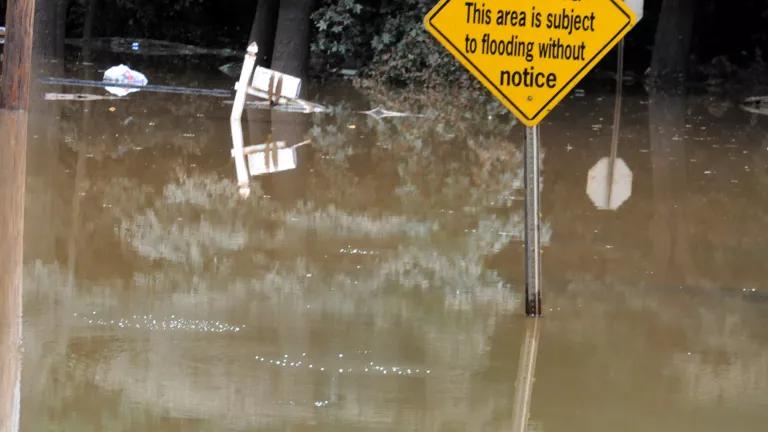
One year ago, President Obama issued a directive to all federal agencies to begin preparing for sea level rise and the increasing risk of flooding caused by climate change. The directive established new federal flood protection standards that will go a long way towards making the nation more resilient. One year and 29 major flood disasters later, agencies are still working to put the standards into effect.
President Obama signed Executive Order 13690 on January 30, 2015, which established the new flood protection standards that all federal agencies are required to meet. Over the last 12 months the Administration held multiple public meetings (see blogs from NRDC about meetings in Iowa, Virginia, and California), finalized guidance to its agencies, and beat back attempts by Congress to derail the standards. Now, all federal agencies should be focused on making sure that the projects they fund are better protected from floods and future sea level rise.
These standards require agencies to ensure that federally-funded facilities, buildings, and infrastructure are built outside of the floodplains of rivers and coastal areas whenever practicable. If a project can't be built on higher ground outside a floodplain, then it must be protected from future flood damages, usually by building higher, according to the design criteria below.
This directive applies some good old-fashioned common sense to keep our infrastructure high and dry. It essentially boils down to "don't build things where they're likely to be flooded" and "if you have to build things where they're likely to be flooded, build them higher so they won't get damaged when it floods." Pretty straight forward, right? It ranks right up there with "an ounce of prevention is worth a pound of cure."
Who could argue with that? It turns out Congress could.
Members of Congress introduced several riders and appropriations bills that would have prohibited the new flood protection standards from going into effect. Ultimately, after months of efforts by the administration and a diverse coalition of groups including NRDC, the Association of State Floodplain Managers, the R Street Institute, and others, Congress decided to not intervene.
Now that agencies can focus on implementing the standards without fear of Congressional interference, what should they be doing? Agencies need to ensure that their funding decisions support the construction of "climate-smart" public facilities and infrastructure that meet one of the criteria below.
Climate-Informed Science Approach: Use the best available climate science data (e.g. sea level rise projections) to determine future flood risks, then move or elevate structures so they're protected from future levels of flooding. This approach is particularly important in coastal areas where sea level rise is an issue and for projects that have long lifetimes. For instance, a new sewage treatment plant may be used for decades, so it's essential to consider how high sea levels might be decades from now.
100-year Flood + Margin of Safety: Move or elevate structures so they're protected two feet above the level of the 100-year flood (a flood that has a 1 percent chance of occurring each year), or three feet above the 100-year flood elevation for critical facilities, like fire stations or hospitals. This approach might be best for facilities with shorter design lifetimes and located near river floodplains.
500-year Flood Approach: Move or elevate structures so they're protected to the elevation of a 500-year flood (a flood that has a 0.2 percent chance of occurring each year). In some areas, the height of 500-year flood may be the best way to go, especially for projects that have longer design lives near river floodplains, or in areas where there is more uncertainty about future climate impacts.
For some agencies, the flood protection standards challenge the conventional way of doing things. For instance, the U.S. Environmental Protection Agency (USEPA) gives money to states to fund the construction of municipal water and sewer treatment plants. These plants are often sited in floodplains because it's easier for them to be in close proximity to water. But that proximity to water is part of the reason why FEMA has spent $7.4 billion to repair water, sewer, and public utilities since 1998. We would be better served to spend a little more now and avoid costly damages later.
Overall, FEMA has spent $48.6 billion since 1998 to help state and local governments flood and hurricane recovery efforts. The bulk of this money has been spent on repairing and rebuilding bridges, treatment plants, roads, and other pieces of public infrastructure and buildings -- just a portion of the overall bill we pay for not taking flood risks into account.
We know from hard-earned experience that we need to build smarter and safer. But the nation has been extremely slow to act on that experience. Now climate change is making it essential that we get ahead of the curve. Agencies moving quickly to implement EO 13690 and the new flood protection standards is an essential step to making the nation more resilient and better prepared for the impacts of climate change and sea level rise.

